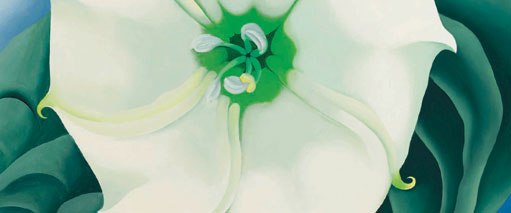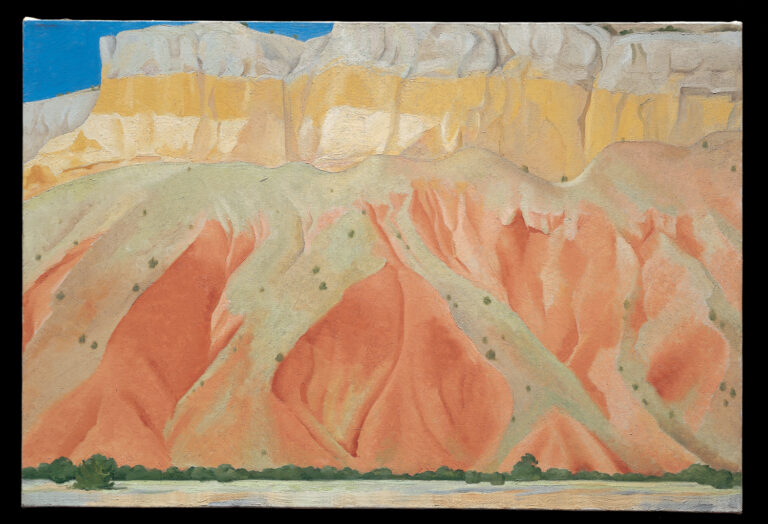Considering the way artists see is one of the most enjoyable games we can play while looking at art. On a recent visit to the Georgia O’Keeffe Museum in Santa Fe (217 Johnson St.), a certain landscape called “Red and Yellow Cliffs” compelled me to stop and look closer. In it, a palette of cream, buttermilk, ochre, sage, rust and deep, dry green gives form to the cliffs. A towering clay escarpment rests on warm, fleshy folds, stretching upward, while sliding rubble pulls the whole thing down to Earth. The cliffs are massive. They nearly stamp out the tiny shrubs cushioning their base. They crowd out even New Mexico’s sky, pushing it so far out of frame that its distinctive expanse is reduced to a patch and a sliver at the top left. Painted in 1940, the year O’Keeffe bought a Ghost Ranch adobe nestled beneath these very cliffs, this painting tells the story of a new home, a new life. It is all land. And as I look longer and slowly unravel it, I too feel at home. At the time I hadn’t an inkling that across the country, Sotheby’s was preparing to auction off three paintings from the O’Keeffe Museum’s permanent collection: “On the Old Santa Fe Road,” “Untitled (Skunk Cabbage)” and “Jimson Weed/White Flower No. 1.” Estimated to bring in $10-15 million, “Jimson Weed” (1932), described by Sotheby’s as “one of the most iconic works by Georgia O’Keeffe ever to appear at auction,” ended up bringing in over $44 million, breaking the record for the highest-selling artwork by a woman. The sale will benefit the museum’s Acquisitions Fund established to grow and refine the collection. It is a watershed event for the institution, says O’Keeffe Museum Director Rob Kret, who spoke with me a few days after the auction. He and Cody Hartley, Director of Curatorial Affairs, describe how the decision to sell—accompanied by over a year of planning, evaluating, negotiating and determining which paintings could be sold without compromising the collection—wasn’t easy. “We found ourselves in a position where, as a young museum, we had to think about ways … we could build the collection so that it’s growing and does represent all of O’Keeffe’s work throughout her lifetime,” explains Kret. Although the museum holds a range of work from early watercolors to late paintings, notes Hartley, there are some gaps that can now be filled to “represent the full breadth of O’Keeffe’s creativity.” Sifting through stories about the sale, and even in conversation with Kret and Hartley, I reflect on my own experience with O’Keeffe’s work just a few days earlier and how far removed it seems from this landmark event. For all the art market buzz, no one really tells us what we’re looking at. A brief report published by People online gives it a go, summing up “Jimson Weed” as a “Georgia O’Keeffe painting of a simple white flower.” Reading that line, the art historian in me winces. I’ve learned that creative work is rarely simple, even if it appears to be so. But the other part of me—the museum goer and art viewer with very particular personal taste—smirks in agreement. Because, see, here’s the thing: “Jimson Weed” just doesn’t do it for me. I don’t connect with it. (And so I also can’t fathom why anyone would shell out $44 million for it. The buyer, by the way, so far remains anonymous.)So I ask Cody Hartley and Rob Kret. Why “Jimson Weed”? What makes this painting so iconic and so special?“First of all, her flowers are the best known to the broad public,” offers Hartley. “Interestingly, the flowers only represent about 8 percent of her activity during her lifetime … [but] they are widely known by the public and beloved, and they were part of establishing her reputation early on. … [“Jimson Weed”] is a large canvas, and she didn’t often paint on a large scale like that. … And it has a very strong history of ownership that goes back to Georgia O’Keeffe’s sister, who owned the painting for a time, and it was on view at the White House for many years, so it’s had a pretty impressive history.” Impressive indeed, but I’m still not sold on “Jimson Weed.” I give it another go. O’Keeffe purportedly first encountered the flower in northern New Mexico on one of her early visits to her future home. It held some meaning for her, then. With that in mind, I pull up an image of the painting and imagine it looming large in front of me. I allow it to just be there, to gradually unfold. I consider the huge green leaves floating against the blue background and the way they frame the single white bloom. These broad planes of cool color suggest a confident hand, and I recall something Hartley said about O’Keeffe’s approach: “We see early on until late in her life a real remarkable confidence in her artwork. She had a very strong vision of what she wanted to achieve, and she realized that with almost no hesitation, no correction, no second guessing. She knew exactly what she wanted, and that’s what she produced.” The circular arrangement of the leaves and shape of the flower urge me inward and suddenly I’m in the middle of it, focused on the smaller, sharper details: the subtle curvature of the pistils set around the very center, dark and deep. It is all flower, and I realize that this is exactly what she wanted—for me to find myself here. Here, as with the landscape, O’Keeffe gives form to the experience of being swallowed by proximity and scale and intrigue. I sense a quest for understanding. This isn’t just a painting of a flower, but a desire—and an invitation—to get closer, to look intently and to experience wholly. Both Kret and Hartley mention their own appreciation for O’Keeffe’s “determined intentionality,” her commitment to living, her ability to immerse herself in the world. “It’s great that we have people coming to the galleries and experiencing her work, but I think it’s only half the experience. Getting out and experiencing the landscape of New Mexico is the rest of the story,” says Kret.“She chose New Mexico for a reason,” he continues. “She chose Abiquiú and Ghost Ranch for certain reasons. She lived 40 years of her life in this place … and through the eyes of this artist, I have learned to appreciate landscape in a way that I probably wouldn’t have otherwise.” That is the power of someone else’s insight—and particularly someone who is a practiced observer. What if we went out, experienced and wondered, filed away our observations and applied this fresh perspective to our own world and the things within it? If we looked like O’Keeffe looked, where might a simple white flower or the hills up the highway take us?
Georgia O’Keeffe Museum
217 Johnson St., Santa Fe
okeeffemuseum.org, (505) 946-1000
Hours: Sunday through Thursday, 10am to 5pm; Friday, 10am to 7pm; Saturday 10am to 5pm. Closes at 3pm Christmas Eve and New Year’s Eve. Closed Christmas and New Year’s Day.Admission: $6 New Mexico residents; $12 general; $10 seniors 60+; $10 students 18+ with ID; $6 military and law enforcement; FREE youth and students 18 and underThe first Friday of the month is FREE for New Mexico residents and their guests (up to 10 guests); valid New Mexico ID required.












